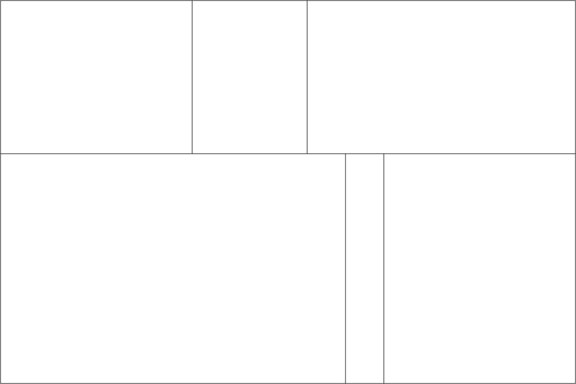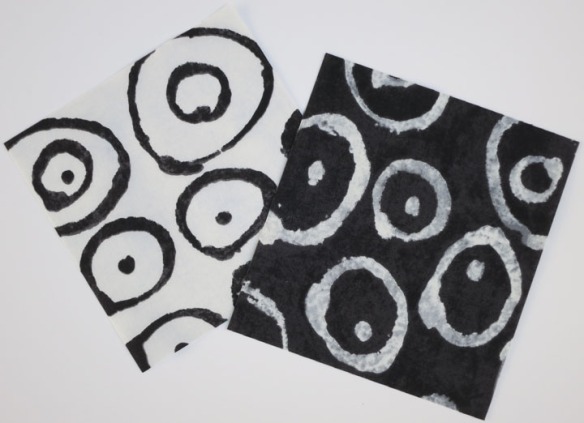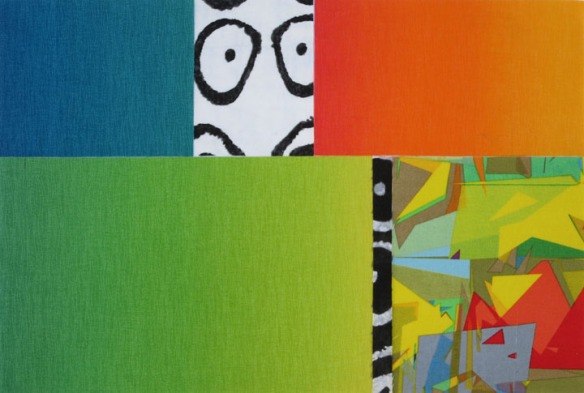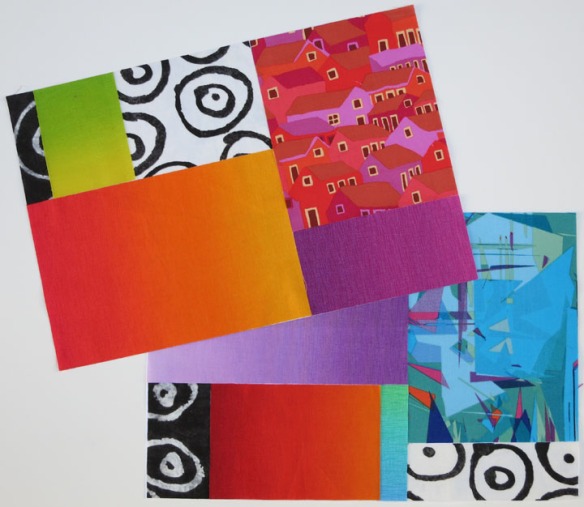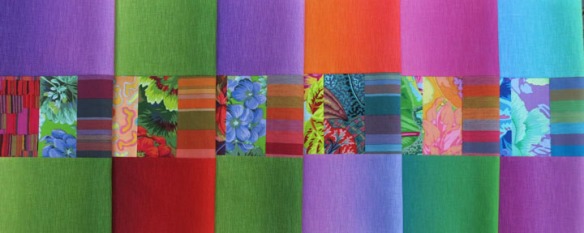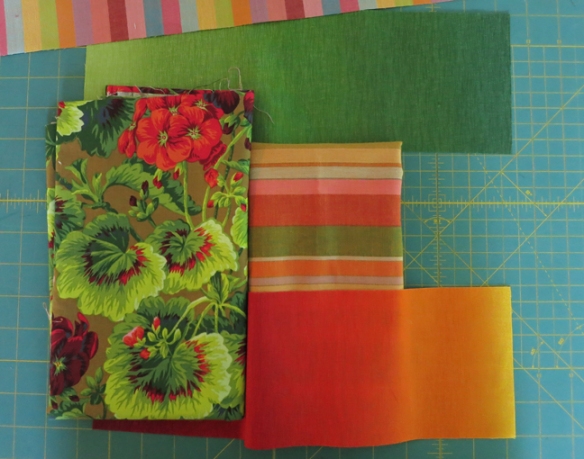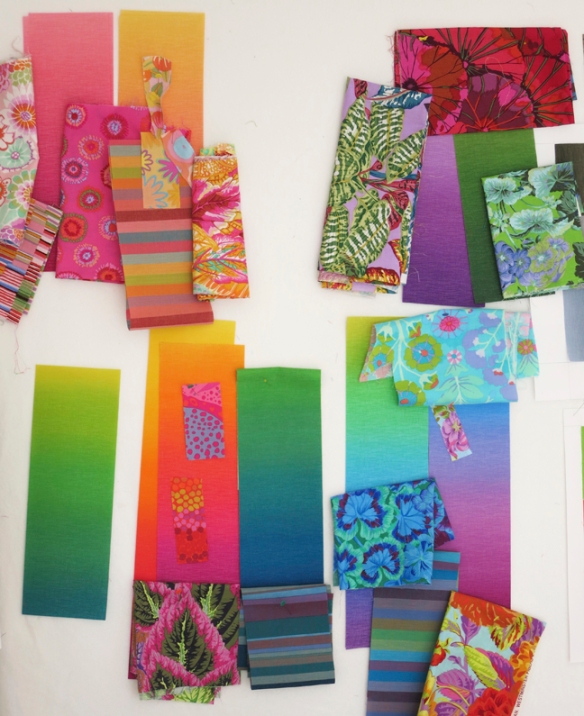by Christine Barnes
I love October! My favorite poem when I was twelve was “October’s Bright Blue Weather,” by Helen Hunt Jackson. The last stanza reads:
O sun and skies and flowers of June,
Count all your boasts together,
Love loveth best of all the year
October’s bright blue weather.
At Zephyr we had both bright blue weather and bright blue water. The changing colors of the lake (sometimes you see bands of different blues, almost like an ombré) made it magical.
The retreat was magical, too. By now you’ve read the post-retreat thoughts of Heidi and Sandra. I heartily second their enthusiastic accounts of our time there. Lest my students feel left out, here are some images from my Luminosity and Luster workshop:
First, she who brings the most fabric . . . has the most to work with.
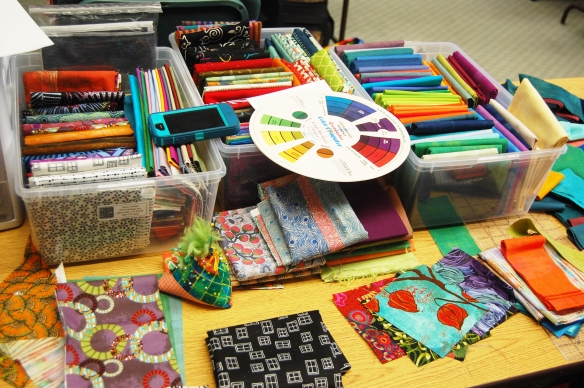 Below are some of the blocks Karen made with her yummy selection of fabrics. Note the “swizzle stick” borders, narrow strips of fabric inserted between the block segments.
Below are some of the blocks Karen made with her yummy selection of fabrics. Note the “swizzle stick” borders, narrow strips of fabric inserted between the block segments. Luster exercises, starting with strips of gray ombré that I provided. How different the blocks look, depending on the choice of fabrics for the center units. Compare the lower left and lower right blocks, for example.
Luster exercises, starting with strips of gray ombré that I provided. How different the blocks look, depending on the choice of fabrics for the center units. Compare the lower left and lower right blocks, for example.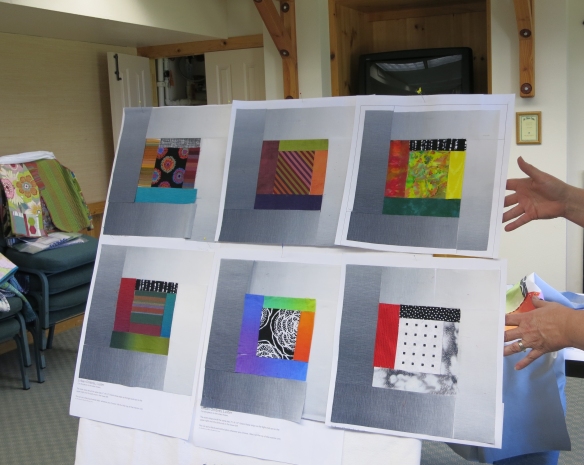 Eileen worked with a pattern she brought, with the idea of creating luminosity.
Eileen worked with a pattern she brought, with the idea of creating luminosity.  As she played with her options, it became apparent that she was also creating transparency, almost by accident. A few days after the retreat ended, Eileen sent me a pic of her quilt top:
As she played with her options, it became apparent that she was also creating transparency, almost by accident. A few days after the retreat ended, Eileen sent me a pic of her quilt top: Aren’t the bands of lighter-value yellow running horizontally through the quilt cool? She gets extra credit, for sure!
Aren’t the bands of lighter-value yellow running horizontally through the quilt cool? She gets extra credit, for sure!
Nancy was also working with luminosity, and I’ll show you her finished quilt in a future post (no pressure, Nancy). Here she’s just relaxing. See how neatly her fabrics are piled at the front of her table? More extra credit. The fabrics choices pinned to the wall are Noelle’s, for her Sassy Circles quilt, but she somehow escaped the camera. Here, Teresa begins to work with Serenity ombrés, Kaffe Fassett stripes, and Marcia Derse prints.
Here, Teresa begins to work with Serenity ombrés, Kaffe Fassett stripes, and Marcia Derse prints. And her blocks take shape. Note the center squares, cut on the bias. They’re a bit harder to work with, but they certainly add movement to the blocks.
And her blocks take shape. Note the center squares, cut on the bias. They’re a bit harder to work with, but they certainly add movement to the blocks.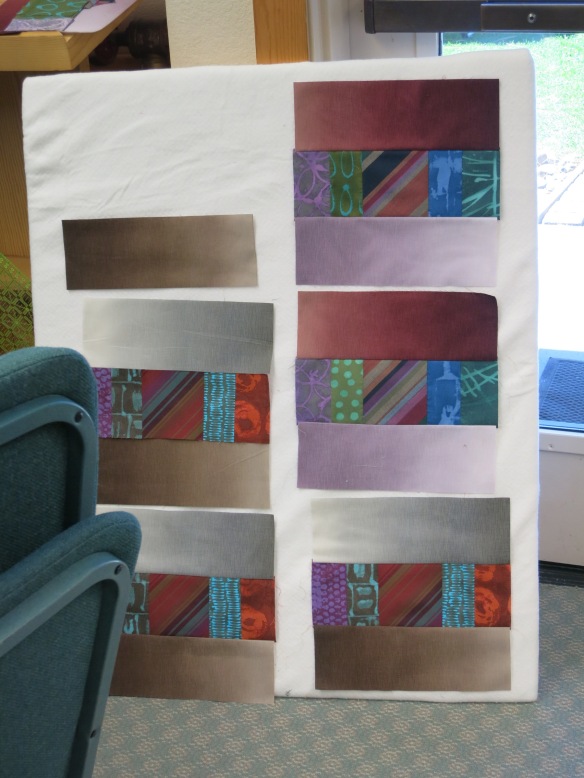 Many thanks to Noelle, Nancy, Nora, Teresa, Karen, Jackie, Eileen, and Cindy. I can’t imagine my time there without you. (I wish I had taken more pics!) I really enjoyed meeting the students in the other classes and seeing their amazing work.
Many thanks to Noelle, Nancy, Nora, Teresa, Karen, Jackie, Eileen, and Cindy. I can’t imagine my time there without you. (I wish I had taken more pics!) I really enjoyed meeting the students in the other classes and seeing their amazing work.
I’m adding this pic of the back of my vest because so many asked me about it. I pieced the vest back, with a green hand-dye on the outside and yellow-green osnaburg on the inside. What you see are the seam allowances, which I purposely put on the outside. The raw edges are bound with 1-inch strips of a Kaffe stripe cut on the bias. This technique is called the Hong Kong seam finish, and if you Google it, you’ll find plenty of videos and still tutorials. We’re working on plans for next year, and we’re very hopeful that we’ll be able to add that extra sewing day. I’m thinking about transparency, one of my favorite light effects. There are two kinds: parent/child and layered. Here’s an example of layered transparency, the illusion that lighter see-through shapes float above darker shapes. There will be a variety of exercises and three or four quilt design options.
We’re working on plans for next year, and we’re very hopeful that we’ll be able to add that extra sewing day. I’m thinking about transparency, one of my favorite light effects. There are two kinds: parent/child and layered. Here’s an example of layered transparency, the illusion that lighter see-through shapes float above darker shapes. There will be a variety of exercises and three or four quilt design options. Finally, I left Zephyr and headed home up the west side of the lake. A stop at the Emerald Bay lookout is almost mandatory. Talk about “bright blue water,” with bits of greener blue.
Finally, I left Zephyr and headed home up the west side of the lake. A stop at the Emerald Bay lookout is almost mandatory. Talk about “bright blue water,” with bits of greener blue. Until next time, enjoy these glorious October days and keep scheming and sewing. Is there anything better?!
Until next time, enjoy these glorious October days and keep scheming and sewing. Is there anything better?!


